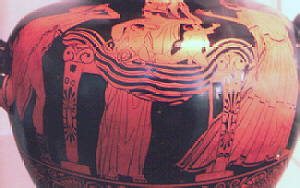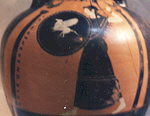
Interestingly, in Pithos A from Kuntillet Ajrud (a caravanserai in eastern Sinai) a painting of two ibexes nibbling on a sacred tree is accompanied by an inscription mentioning "Yahweh of Samaria and his asherah [not Asherah!]" (Taylor p. 32).
A distinction must be made between Asherah and ashera. The former is a goddess mentioned in Ugaritic and other Canaanite texts and probably in 2 Kings 21.7 which mentions an "image (pesel) of Asherah" (or, with Lipinski [p. 113], that the ashera contained an "image"). See Hess, Richard S. (1996). "Asherah or Asherata". Orientalia, 65, 209-19.Numerous passages in the Bible indicate that the latter is a cultic structure embodying "planted" (wooden) pillars (Deut. 16.21).Reed cited by Binger, Tilde. (1997). Asherah: Goddesses in Ugarit, Israel and the Old Testament. Sheffield: Sheffield University Press, pp. 122-3; compare Taylor, Joan E. (1995). "The Asherah, the Menorah and the Sacred Tree." Journal for the Study of the Old Testament, 66, 29-54 (esp. 36-8).
It is consistent with the cult-structure perspective that a number of Near Eastern words cognate to asherah denote a cultic structure. For example, according to CAD (ashirtu A), Akkadian ashirtu has such meanings as sanctuary and, significantly, "socle (in the form of a sanctuary, for images, symbols, etc.)" See Lipinski, E. (1972). "The Goddess Atirat in Ancient Arabia, in Babylon, and in Ugarit". Orientalia Lovaniensia Periodica, 3, 101-19. In Phoenician inscriptions of the second half of the first millennium BCE "ashtart" clearly has the meaning "shrine": "to Ashtart in the ashtart of El Hmn" (222 BCE); "to Lady Ashtart this holy ashtart (is dedicated)" (5th-4th centuries BCE); "By order: to the guild of (metal?) artisans; they shall give a valuable basin to slt, the overseer of the ashtart" (earlier 5th century BCE from the port of Akko). For the evidence from Phoenician inscriptions, see Wiggins, Steve A. (1993). A Reassessment of 'Asherah': A Study According to the Textual Sources for the First Two Millennia B.C.E. Kevelaer: Butzon & Bercker, 185-6; Dothan, M. (1985). "A Phoenician Inscription from `Akko". Israel Exploration Journal, 35, 81-94. In the Septuagint ashera is translated mostly as alsos which Reed sees as a gloss or designation of an object used in the pagan cult rather than a grove cited by Binger, 130-3. LSJ (s.v.)includes the meaning "grove" but more broadly alsos seems to mean "any hallowed precinct, even without trees". Any goddess occupying the ashera might me referred to as Asherah.(See the Septuagint translations of 2 Chron. 15.16 and 24.18.) Further, in the Septuagint Astarte is sometimes translated as tóalsos (Binger 132).
My hypothesis is that the asherah is the same kind of structure known in the ancient Greek world as dokana: two upright supports connected by two cross-beams that frame a goddess or her symbol, a "sacred tree", perhaps in a window or behind a lattice.The question of glyptic evidence demonstrating an association of Asherah with sacred trees is discussed by Hestrin, see Ackerman, Susan. (1997). "The Queen Mother and the Cult in the Ancient Near East." In Karen L. King, Women and Goddess Traditions. Minneapolis: Fortress Press, 191-2.
With respect to the occupancy of the asherah by the symbol of a goddess, note that the "Lachish ewer", generally dated to the thirteenth century, depicts a pair of lions, in one case flanking a goddess and in the other flanking a sacred tree and ibexes. As Taylor (p. 32) explains, it is "as if the tree and the anthropomorphic image are interchangeable." 
Interestingly, in Pithos A from Kuntillet Ajrud (a caravanserai in eastern Sinai) a painting of two ibexes nibbling on a sacred tree is accompanied by an inscription mentioning "Yahweh of Samaria and his asherah [not Asherah!]" (Taylor p. 32).
asherah not Asherah since we would not expect the possessive suffix "his" on a proper name. Indeed, the use of such pronouns with personal or divine names is unprecedented in biblical and epigraphic Hebrew. It is true that the suffixed possessive pronoun attached to a personal or divine name is found in other Semitic languages including Akkadian, Eblaite, Arabic and, probably, Ugaritic. But why reach to other languages when there is ample evidence of asherah as a cultic object in biblical Hebrew? Further, it is not really obvious what "his Asherah" means. Thus, "his Asherah," taken as referring to the goddess (with a capital A) as a consort of YHWH is very doubtful on both linguistic and semantic grounds. See further, Hadley, Judith M. (2000). The Cult of Asherah in Israel and Judah: Evidence for a Hebrew Goddess. Cambridge: Cambridge University Press, pp. 152-55; Schmidt, Brian R. (2002). "The Iron Age Pithoi Drawings from Horvat Teman or Kuntillet `Ajrud: Some New Proposals. Journal of Ancient Near Eastern Religions, 2, 91-125.
The drawing and inscription have been placed in the 9th-8th century. The motif of two animals being fed by a goddess or browsing the sacred tree is a very old one in ancient art. Note, on the left, the "mistress of animals" from Ugarit (14th century) and, on the right, a small shell plaque from Pu-abi's grave at Ur (mid-third millennium).

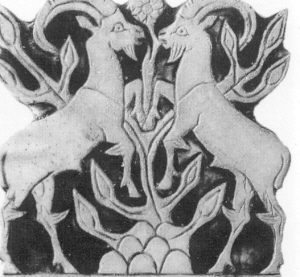
The two upright supports represent twin agents ("heroes") of the goddess in the window. In Laconia the goddess in the window or lattice was Helen who was flanked by the Dioskouroi. The Dioskouroi are known as twin oath-gods and Helen, the "Rhamnusian", as the daughter of Nemesis of Rhamnous in Attica was probably an oath-goddess. Note that the Roman iugum, the shrine of the Lares Compitales, was "planted" in the ground. (The Latin word is figo which is "the word used for fastening votives to a temple doorpost or wall and of planting a tree or vine-stock, and of setting a post firmly in the ground" [Holland 430].) The iugum was a crossbeam supported by two uprights. The Lares Compitales were known as "the heroes who stand by the door or gate" (Holland 432). Bakker (p. 199) refers to a calendar-painting from Ostia in which Diana, holding a bow, stands in a gate-like structure consisting of two torches connected by a horizontal beam.Holland, Louise Adams. (1937). "The Shrine of the Lares Compitales. Transactions of the American Philological Society, 68, 428-41.Bakker, Jan Theo. (1994). Living and Working with the Gods: Studies of Evidence for Private Religion and its Material Environment in the City of Ostia (100-500 AD). Amsterdam: Gieben.
Twins, Shahar and Shalim (the "Gracious Gods"), are associated with Ashera in a Ugaritic text (KTU 1.23) Dijkstra, M. (1998). "Astral Myth of the Birth of Shahar and Shalim." In Manfred Dietrich and Ingo Kottsieper (eds.), "Und Mose shrieb dieses Lied auf": Studien zum Alten Testament und zum Alten Orient. Münster: Ugarit-Verlag, 265-87 (esp. 270-1). Israel, of course, had several sets of twins capable of fulfilling the role of the Dioskouroi including Jachin and Boaz, Jacob and Israel, and Samson and ?. There is some reason to think that oaths were sworn before Israel's asherah. Amos (8.14) scornfully notes that oaths were sworn "by the sin of Samaria". But shmt shmrn has frequently been emended to read "by the ashera of Samaria" shrt shmrn which is mentioned in 2 Kings 13.6.
The images displayed below are intended to show us what Israel's ashera might have looked like.
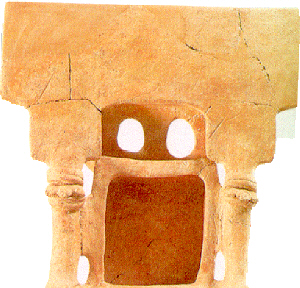
Source: Irène Lewitt (ed.) (1995). The Israel Museum. New York: Vendome Press, page 64.
Caption:
Model Shrine
Vicinity of Mt Nebo, Transjordan
Israelite period
9th-8th century BCE
Pottery
H 29 cm (11 1/2 in) W 31 cm (12 1/4 in)
Gift of the Reuben and Edith Hecht Trust, Haifa
This gracefully executed model shrine consists of a small cubiculum attached to a tall façade. Rectangular in shape, the cubiculum's floor extends forward to produce a threshold. The two freestanding columns flanking the entrance to the cubiculum are surmounted by capitals decorated with a row of drooping petals, a popular motif in the art and architecture of the period. Large rectangular blocks rest on the capitals, and above them is a broad rectangular entablature.
Models of houses from Mesopotamia and the Levant, some bearing symbols attributed to specific deities, date back to the third millennium BCE, and are believed to represent the houses of deities. Sometimes they contain a figure in the cubiculum, presumably of that deity. They were probably presented to the gods in their temples, or kept at home for private cultic use, or placed in tombs.
This model shrine, found in Transjordan, and similar ones from Eretz Israel no doubt reflect the Canaanite-Phoenician tradition of temple architecture. The large façade recalls the entrance to Solomon's Temple which, according to the Bible, also had two freestanding bronze columns, referred to as "Yakhin" and "Boaz" (1 Kings 7:21).
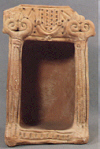
Tell el-Far`ah shrine.
This shrine model comes from Tell el-Far`ah (north). It was found in a pit in the courtyard of a residence in Str. VIIb (end of the tenth century). The door is flanked by floral capital columns. Red polished pottery is characteristic of the period.
Source: Keel, Othamar and Christoph Uelinger. (1998). Gods, Goddesses, and Images of God in Ancient Israel. Minneapolis: Fortress, p. 162 with fig. 188a (citing Chambon 1984, 77f).
Click here for full size image

Transjordan shrine
Original archaeological context unknown but said to come from Transjordan. Dated to the tenth or early ninth century. The dove indicates the shrine of a goddess.
Source: Hachlili, Rachel and Yaakov Meshorer. (1990).Highlights from the Collection of the Reuben and Edith Hecht Museum, 2d. ed. Haifa: University of Haifa, p. 42.
Click here for full size image
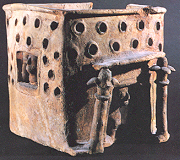
Two free-standing columns on either side of the entrance framing a deity, a "winged siren". The capitals in the form of lotus flowers are, it is reported in the source, of an Egyptianizing style. The date attributed to the model is the 6th century BCE.
Sources: Karageorghis, Vassos. ((1976). Kition: Mycenaean and Phoenician Discoveries in Cyprus. London: Thames and Hudson, p. 140 with pl. 106. Karageorghis, Vassos. (1988). "Cyprus". In Sabatino Moscati (scientific director). The Phoenicians, New York: Abbeville Press, p. 163.
Another Cypriot "shrine" from the Louvre, dating again to the 6th century BCE, features the "woman in the window" (added October 4, 2000)
Click here for full size image

Goddess depicted on 8th century terracotta wall-bracket from Kition(?) in Cyprus (added March 5, 2000). Source: Caubet, A., A. Hermary and V. Karageorghis. (1992). Art Antique de Chypre au Musée du Louvre. Paris: Réunion des Musées Nationaux, 107-8.
Click here for full size image

Phoenician plaques dated from c. 1000 to 800 display a goddess (female figure) standing within the facade of a shrine or temple with a cornice supported by two papyriform columns. This family of plaques includes one complete model and fragments of 13 others found in the "foreign quarter" at Memphis. The facade is said to manifest an Egyptianizing style. W.A. Ward (1996: 16) notes that
We see here the combination of elements from several artistic traditions that characterizes Canaanite art from the first half of the second millennium B.C. through the Late Bronze Age, and into the classical Phoenician period of the Iron Age. In spite of the syncretistic nature of these pieces, one gets the impression that real structures underlie these facades. While Mazar suggests that Egyptian naos shrines constitute the prototype, these do not have the papyriform columns that characterize the Phoenician plaques.... The Egyptian form of the facades on the plaques can be seen at its best at the small temple of Medinet Habu where a portico of two papyriform columns and a flat wooden cornice roof was added in front of the Ptolemaic pylon. While this Ptolemaic portico was built as a permanent part of the pylon entrance, it derives from earlier prototypes as illustrated in an ancient depiction of the entrance pylon of the temple of Amun at Karnak.Source: Ward, W.A. (1996). "The Goddess Within the Facade of a Shrine: A Phoenician Clay Plaque of the 8th Century B.C." Rivista di studi finici, 24, 7-19.




Click here for full size image
